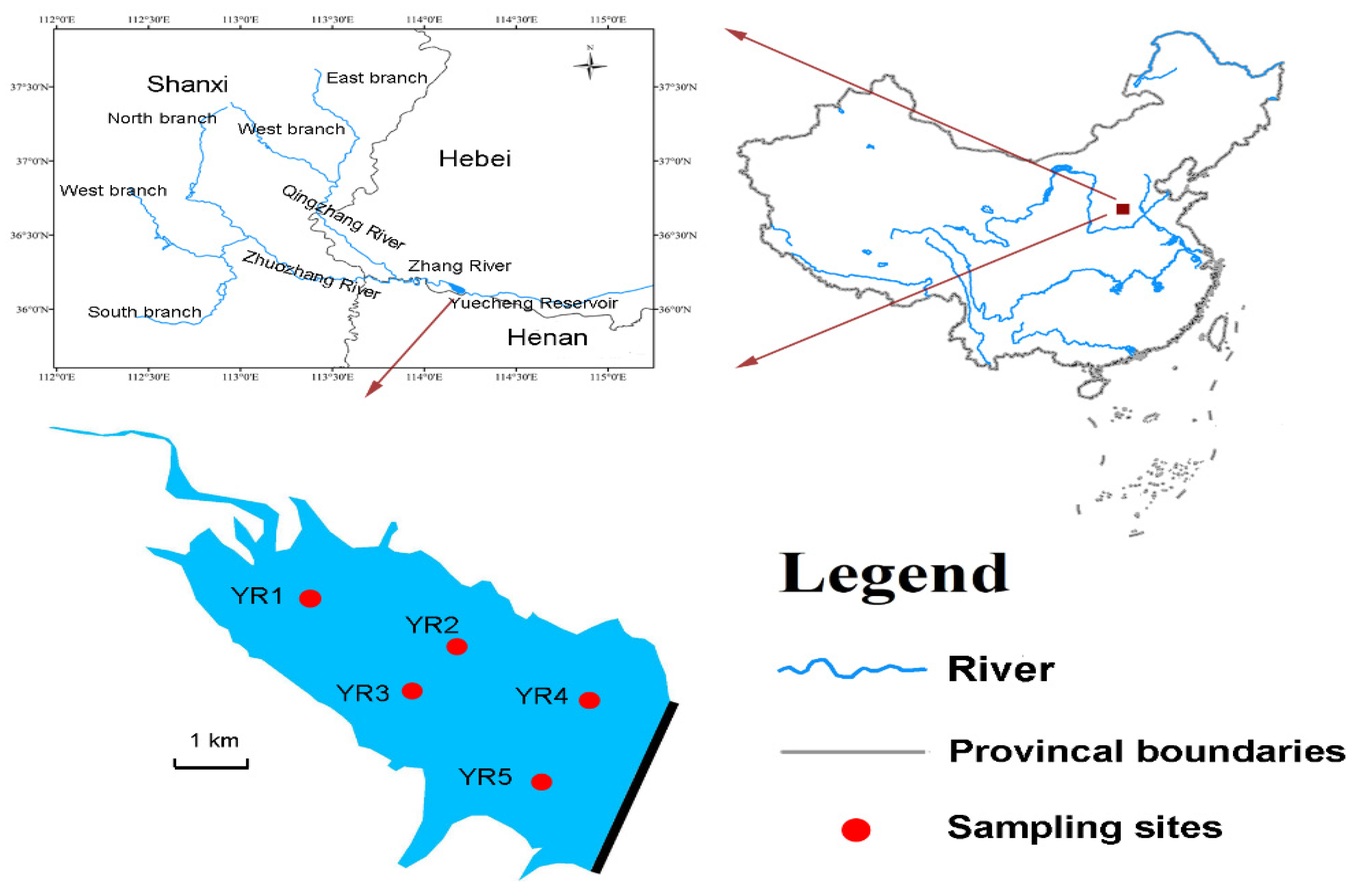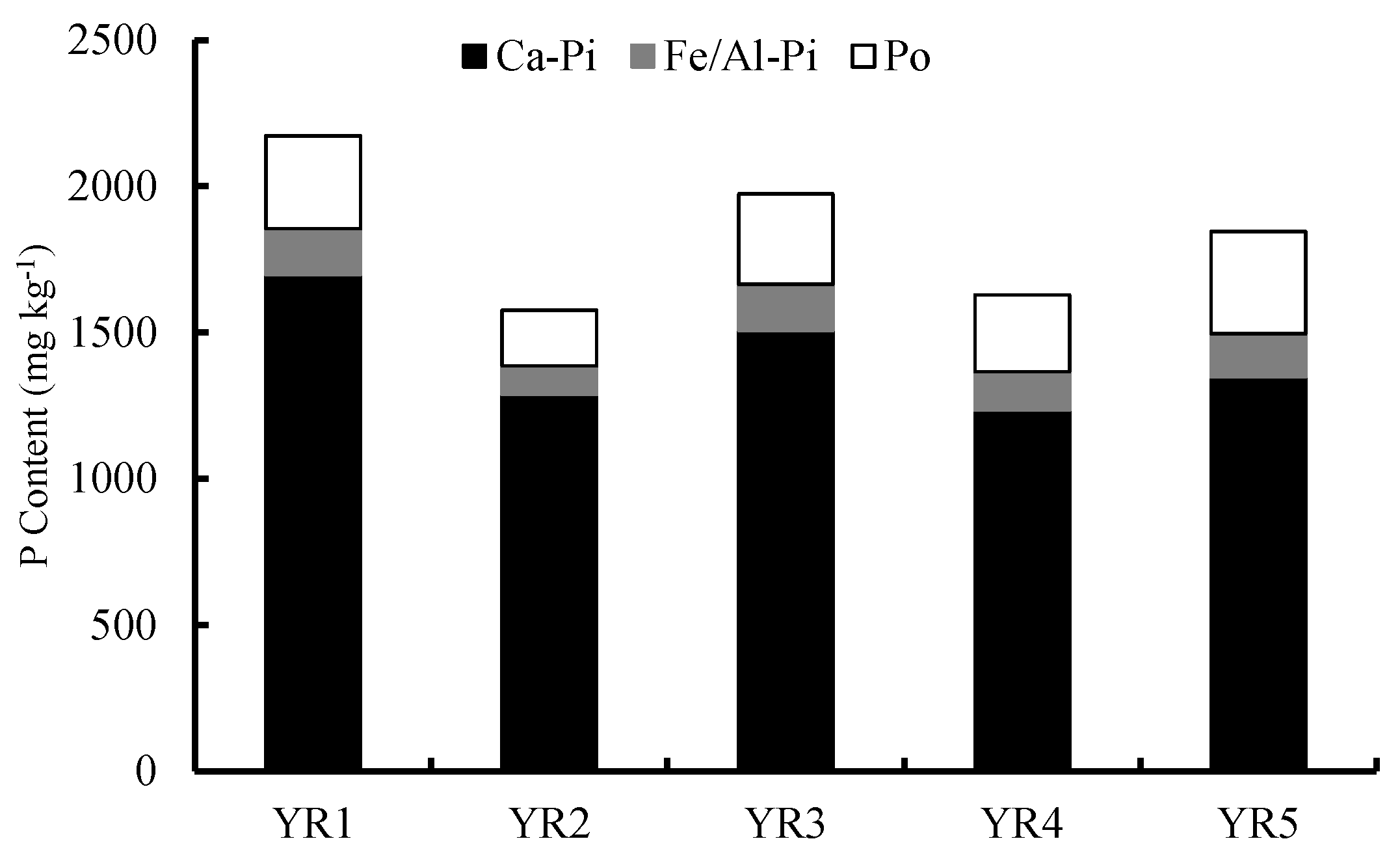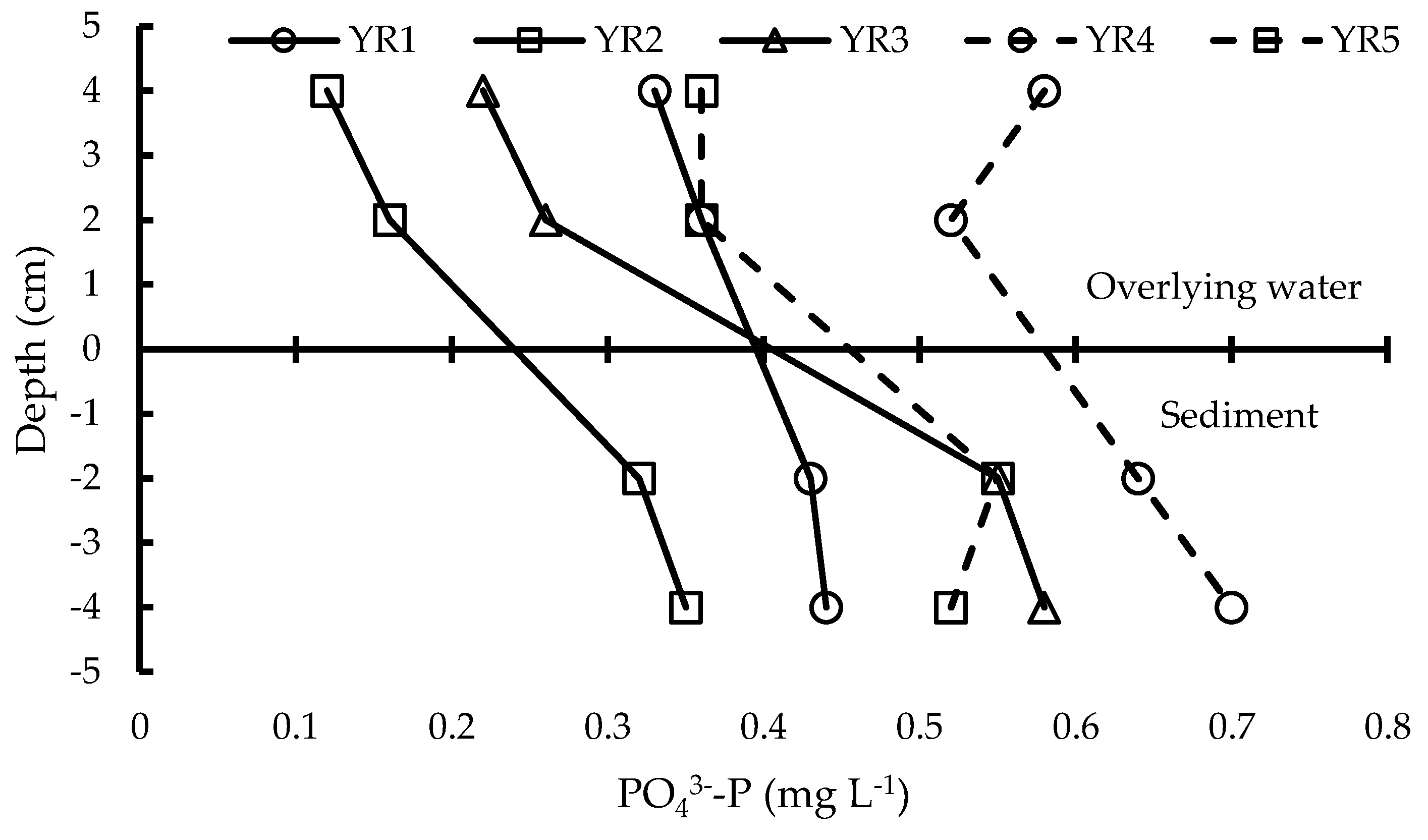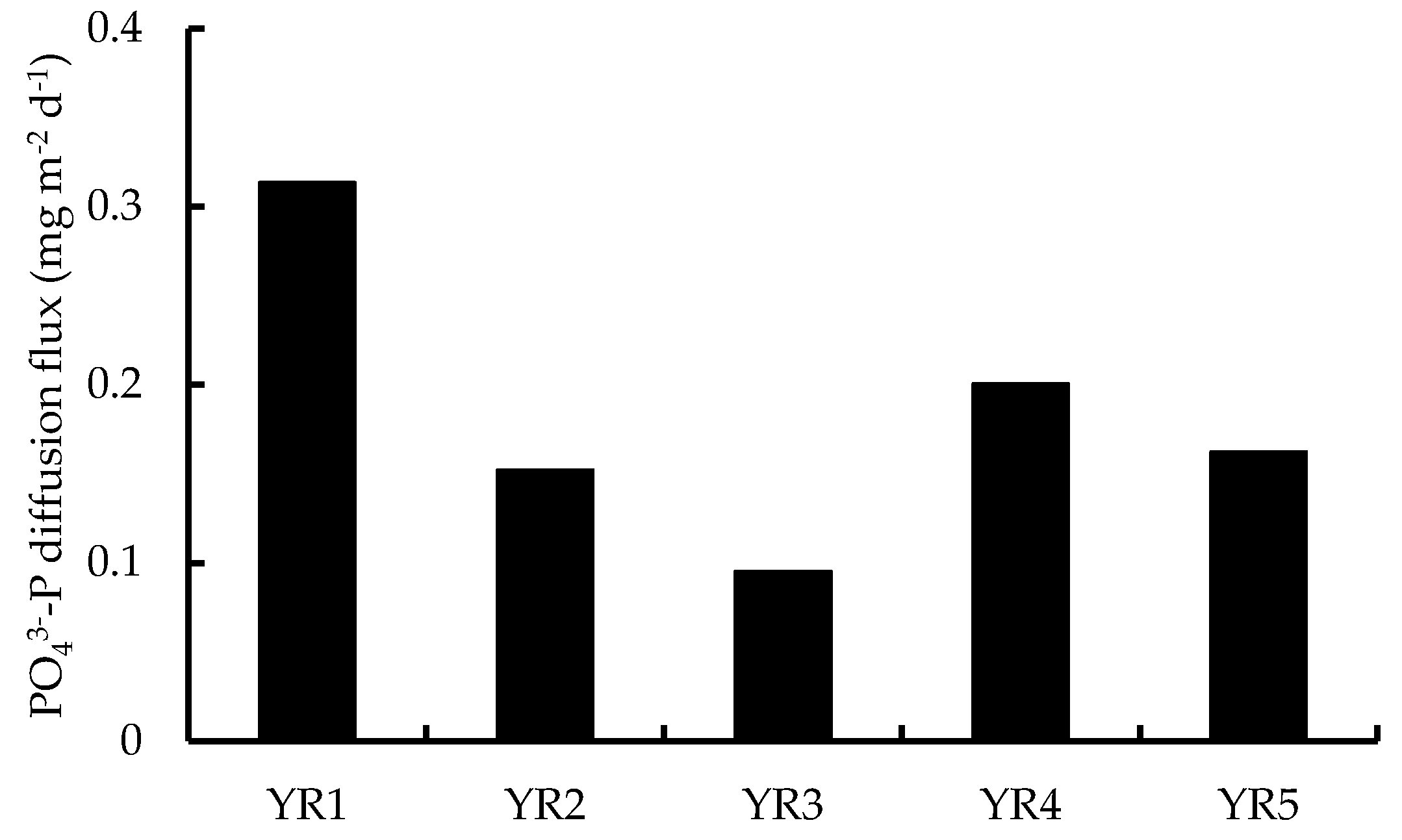Phosphorus Fractions in the Sediments of Yuecheng Reservoir, China
Abstract
1. Introduction
2. Materials and Methods
2.1. Study Area and Sampling Sites
2.2. Water Chemistry
2.3. Sediment. Sample Analysis
2.4. Flux Estimation and Data Analysis
3. Results and Discussion
3.1. Physicochemical Properties of Overlying Water and Interstitial Water
3.2. Characteristics of the Surface Sediment
3.3. Phosphorus Fraction Composition
3.4. Estimated Diffusion Fluxes of PO43−–P
3.5. Relationship of Sediment Characteristics and P Fractions
4. Conclusions
Author Contributions
Funding
Conflicts of Interest
References
- Correll, D. Phosphorus: A rate limiting nutrient in surface waters. Poult. Sci. 1999, 78, 674–682. [Google Scholar] [CrossRef] [PubMed]
- Reddy, K.; Kadlec, R.; Flaig, E.; Gale, P. Phosphorus retention in streams and wetlands: A review. Crit. Rev. Environ. Sci. Technol. 1999, 29, 83–146. [Google Scholar] [CrossRef]
- Correll, D.L. The role of phosphorus in the eutrophication of receiving waters: A review. J. Environ. Qual. 1998, 27, 261–266. [Google Scholar] [CrossRef]
- Pan, G.; Krom, M.D.; Herut, B. Adsorption—Desorption of phosphate on airborne dust and riverborne particulates in east mediterranean seawater. Environ. Sci. Technol. 2002, 36, 3519–3524. [Google Scholar] [CrossRef] [PubMed]
- Pan, G.; Krom, M.D.; Zhang, M.; Zhang, X.; Wang, L.; Dai, L.; Sheng, Y.; Mortimer, R.J.G. Impact of suspended inorganic particles on phosphorus cycling in the yellow river (China). Environ. Sci. Technol. 2013, 47, 9685–9692. [Google Scholar] [CrossRef]
- Chuai, X.; Ding, W.; Chen, X.; Wang, X.; Miao, A.; Xi, B.; He, L.; Yang, L. Phosphorus release from cyanobacterial blooms in meiliang bay of lake taihu, China. Ecol. Eng. 2011, 37, 842–849. [Google Scholar] [CrossRef]
- Huang, L.; Fu, L.; Jin, C.; Gielen, G.; Lin, X.; Wang, H.; Zhang, Y. Effect of temperature on phosphorus sorption to sediments from shallow eutrophic lakes. Ecol. Eng. 2011, 37, 1515–1522. [Google Scholar] [CrossRef]
- Wang, Y.; Shen, Z.; Niu, J.; Liu, R. Adsorption of phosphorus on sediments from the three-gorges reservoir (China) and the relation with sediment compositions. J. Hazard. Mater. 2009, 162, 92–98. [Google Scholar] [CrossRef]
- Młynarczyk, N.; Bartoszek, M.; Polak, J.; Sułkowski, W. Forms of phosphorus in sediments from the goczałkowice reservoir. Appl. Geochem. 2013, 37, 87–93. [Google Scholar] [CrossRef]
- Qin, L.; Zeng, Q.; Zhang, W.; Li, X.; Steinman, A.D.; Du, X. Estimating internal p loading in a deep water reservoir of northern China using three different methods. Environ. Sci. Pollut. Res. 2016, 23, 18512–18523. [Google Scholar] [CrossRef]
- Elser, J.; Bennett, E. Phosphorus cycle: A broken biogeochemical cycle. Nature 2011, 478, 29. [Google Scholar] [CrossRef] [PubMed]
- Zhang, W.; Jin, X.; Zhu, X.; Shan, B.; Zhao, Y. Phosphorus characteristics, distribution, and relationship with environmental factors in surface sediments of river systems in Eastern China. Environ. Sci. Pollut. Res. 2016, 23, 19440–19449. [Google Scholar] [CrossRef] [PubMed]
- Liu, J.; Li, Y.; Huang, G.; Zeng, X. A dual-interval fixed-mix stochastic programming method for water resources management under uncertainty. Resour. Conserv. Recycl. 2014, 88, 50–66. [Google Scholar] [CrossRef]
- Liu, J.; Li, Y.; Huang, G.; Zhuang, X.; Fu, H. Assessment of uncertainty effects on crop planning and irrigation water supply using a monte carlo simulation based dual-interval stochastic programming method. J. Clean. Prod. 2017, 149, 945–967. [Google Scholar] [CrossRef]
- Bao, Y.; Wang, Y.; Hu, M.; Wang, Q. Phosphorus fractions and its summer flux from sediments of deep reservoirs located at a phosphate-rock watershed, Central China. Water Sci. Technol. Water Supply 2017, 18, 688–697. [Google Scholar] [CrossRef]
- Association, A.P.H.; Association, A.W.W.; Federation, W.P.C.; Federation, W.E. Standard Methods for the Examination of Water and Wastewater; American Public Health Association: Washington, DC, USA, 1915; Volume 2. [Google Scholar]
- Zhang, W.; Jin, X.; Zhu, X.; Shan, B. Characteristics and distribution of phosphorus in surface sediments of limnetic ecosystem in Eastern China. PLoS ONE 2016, 11, e0156488. [Google Scholar] [CrossRef]
- Berner, R.A. Early Diagenesis: A Theoretical Approach; Princeton University Press: Princeton, NJ, USA, 1980. [Google Scholar]
- Krom, M.D.; Berner, R.A. The diffusion coefficients of sulfate, ammonium, and phosphate ions in anoxic marine sediments 1. Limnol. Oceanogr. 1980, 25, 327–337. [Google Scholar] [CrossRef]
- Cade-Menun, B.J. Characterizing phosphorus in environmental and agricultural samples by 31p nuclear magnetic resonance spectroscopy. Talanta 2005, 66, 359–371. [Google Scholar] [CrossRef]
- Meyers, P.A.; Lallier-Vergès, E. Lacustrine sedimentary organic matter records of late quaternary paleoclimates. J. Paleolimnol. 1999, 21, 345–372. [Google Scholar] [CrossRef]
- Kaiserli, A.; Voutsa, D.; Samara, C. Phosphorus fractionation in lake sediments—Lakes Volvi and Koronia, N. Greece. Chemosphere 2002, 46, 1147–1155. [Google Scholar] [CrossRef]
- Perez, E.; Sulbaran, M.; Ball, M.M.; Yarzabal, L.A. Isolation and characterization of mineral phosphate-solubilizing bacteria naturally colonizing a limonitic crust in the south-eastern venezuelan region. Soil Biol. Biochem. 2007, 39, 2905–2914. [Google Scholar] [CrossRef]
- Yao, Y.; Wang, P.; Wang, C.; Hou, J.; Miao, L.; Yuan, Y.; Wang, T.; Liu, C. Assessment of mobilization of labile phosphorus and iron across sediment-water interface in a shallow lake (Hongze) based on in situ high-resolution measurement. Environ. Pollut. 2016, 219, 873–882. [Google Scholar] [CrossRef] [PubMed]
- Mao, J.; Wang, Y.; Zhao, Q.; Wu, X. Preliminary study on phosphorus release of internal load in dianchi lake sediment. J. China Inst. Water Resour. Hydropower Res. 2005, 3, 229–233. [Google Scholar]
- Zhang, R.-Y.; Wang, L.-Y.; Wu, F.-C.; Zhu, Y.-R. Distribution patterns of phosphorus forms in sediments interstitial water of lake taihu and the effects of sediment-water phosphorus release in spring. Chin. J. Ecol. 2012, 31, 902–907. [Google Scholar]
- Qiu, H.; Geng, J.; Ren, H.; Xu, Z. Phosphite flux at the sediment–water interface in northern lake taihu. Sci. Total Environ. 2016, 543, 67–74. [Google Scholar] [CrossRef]
- Wang, Y.; Niu, F.; Xiao, S.; Liu, D.; Chen, W.; Wang, L.; Yang, Z.; Ji, D.; Li, G.; Guo, H. Phosphorus fractions and its summer’s release flux from sediment in the China’s three gorges reservoir. J. Environ. Inform. 2015, 25, 36–45. [Google Scholar] [CrossRef]
- Yuan, Y.; Bi, Y.; Zhu, K.; Hu, Z. Alkaline phosphatase activity in the sediments of the three gorges reservoir. Environ. Sci. Technol. 2014, 37, 60–64. [Google Scholar]
- Sudha, V.; Ambujam, N.K. Characterization of bottom sediments and phosphorus fractions in hyper-eutrophic krishnagiri reservoir located in an agricultural watershed in India. Environ. Dev. Sustain. 2013, 15, 481–496. [Google Scholar] [CrossRef]




| Sample | PO43−–P (mg L−1) a | PO43−–P (mg L−1) b | T (°C) | DO (mg L−1) | Ph | EC (μS cm−1) | ORP (mv) |
|---|---|---|---|---|---|---|---|
| YR1 | 0.35 ± 0.02 | 0.44 ± 0.01 | 18.7 | 6.1 | 8.42 | 479.6 | 117.9 |
| YR2 | 0.14 ± 0.03 | 0.34 ± 0.02 | 18.5 | 6.5 | 7.92 | 462.3 | 148.6 |
| YR3 | 0.24 ± 0.03 | 0.57 ± 0.02 | 18.4 | 5.2 | 8.07 | 468.9 | 124.7 |
| YR4 | 0.55 ± 0.04 | 0.67 ± 0.04 | 18.8 | 6.7 | 8.26 | 464.7 | 137.2 |
| YR5 | 0.37 ± 0.01 | 0.54 ± 0.02 | 18.7 | 5.8 | 8.22 | 470.4 | 132.8 |
| Sample | Moisture (%) | Porosity (%) | Clay (%) | Silt (%) | Sand (%) | TP (mg·kg−1) | TN (g·kg−1) | TOC (g·kg−1) |
|---|---|---|---|---|---|---|---|---|
| YR1 | 61.1 | 80.3 | 29.5 | 66.7 | 3.8 | 2172.6 | 8.2 | 109.6 |
| YR2 | 62.2 | 81.5 | 43.5 | 53.2 | 3.3 | 1576.3 | 7.0 | 75.4 |
| YR3 | 64.7 | 83.1 | 40.3 | 57.4 | 2.3 | 1972.8 | 8.1 | 108.6 |
| YR4 | 65.7 | 83.3 | 42.3 | 55.2 | 2.5 | 1627.3 | 7.7 | 95.6 |
| YR5 | 63.1 | 82.7 | 44.3 | 52.8 | 2.9 | 1844.7 | 7.4 | 97.5 |
| Site | TP (mg kg−1) | PO43−–P Diffusion Fluxes (mg m−2 d−1) | Reference |
|---|---|---|---|
| Hongze Lake, China | 76.6–932.2 | 0.172–0.793 | [25] |
| Dianchi Lake, China | 1537–4695 | 1.00–4.36 | [26] |
| Taihu Lake, China | 213.7–724.4 | 0.76–4.57 | [27,28] |
| Three Gorges Reservoir, China | 415.5–1047.9 | −0.003–0.013 | [24,29] |
| Yuecheng Reservoir, China | 1576.3–2172.6 | 0.10–0.31 | This study |
| Sample | TP | TN | TOC | C/N | Po | Fe/Al-Pi | Ca-Pi |
|---|---|---|---|---|---|---|---|
| TP | 1 | ||||||
| TN | 0.77 ** | 1 | |||||
| TOC | 0.82 ** | 0.84 * | 1 | ||||
| C/N | 0.64 * | 0.49 | 0.88 ** | 1 | |||
| Po | 0.72 * | 0.61 | 0.79 ** | 0.76 * | 1 | ||
| Fe/Al-Pi | 0.75 * | 0.64 * | 0.86 ** | 0.85 ** | 0.82 ** | 1 | |
| Ca-Pi | 0.95 ** | 0.71 * | 0.68 * | 0.46 | 0.49 | 0.56 | 1 |
© 2019 by the authors. Licensee MDPI, Basel, Switzerland. This article is an open access article distributed under the terms and conditions of the Creative Commons Attribution (CC BY) license (http://creativecommons.org/licenses/by/4.0/).
Share and Cite
Dang, C.; Lu, M.; Mu, Z.; Li, Y.; Chen, C.; Zhao, F.; Yan, L.; Cheng, Y. Phosphorus Fractions in the Sediments of Yuecheng Reservoir, China. Water 2019, 11, 2646. https://doi.org/10.3390/w11122646
Dang C, Lu M, Mu Z, Li Y, Chen C, Zhao F, Yan L, Cheng Y. Phosphorus Fractions in the Sediments of Yuecheng Reservoir, China. Water. 2019; 11(12):2646. https://doi.org/10.3390/w11122646
Chicago/Turabian StyleDang, Chenghua, Ming Lu, Zheng Mu, Yu Li, Chenchen Chen, Fengxia Zhao, Lei Yan, and Yao Cheng. 2019. "Phosphorus Fractions in the Sediments of Yuecheng Reservoir, China" Water 11, no. 12: 2646. https://doi.org/10.3390/w11122646
APA StyleDang, C., Lu, M., Mu, Z., Li, Y., Chen, C., Zhao, F., Yan, L., & Cheng, Y. (2019). Phosphorus Fractions in the Sediments of Yuecheng Reservoir, China. Water, 11(12), 2646. https://doi.org/10.3390/w11122646






